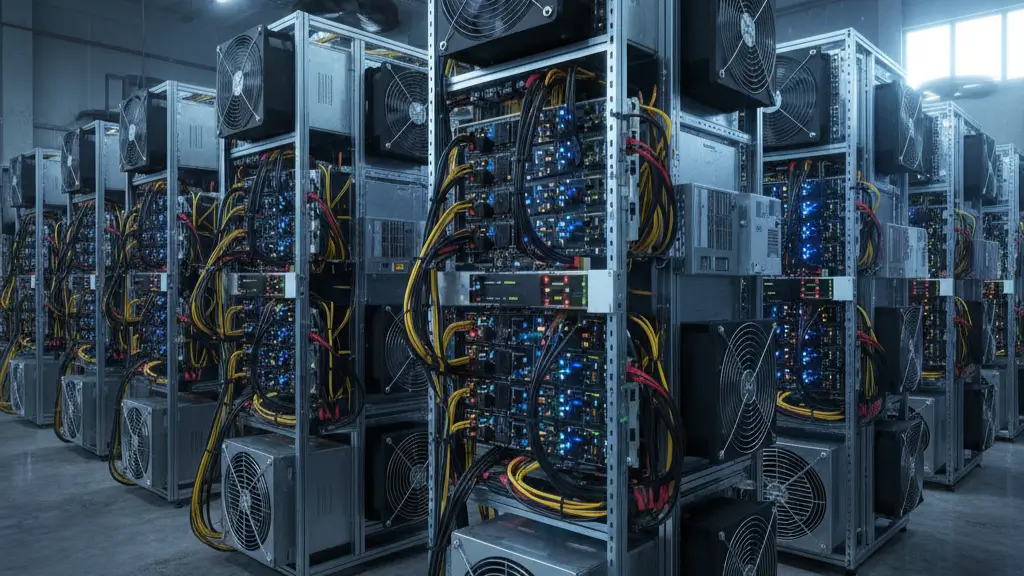Bitcoin Mining Rig: How to Build a Powerful Setup for 2025
2025年10月20日
What Is a Bitcoin Mining Rig?
A Bitcoin mining rig is a specially designed computer system used to solve complex mathematical problems that validate transactions on the Bitcoin network. When a miner successfully solves these problems, they are rewarded with newly minted Bitcoin.
In simpler terms, a mining rig is the “engine” that powers the Bitcoin network. It provides the computational power—also known as hashrate—needed to maintain blockchain security and process new blocks.
While Bitcoin mining began with simple home computers, today’s mining rigs are far more advanced. Specialized machines called ASICs (Application-Specific Integrated Circuits) dominate the market because they’re designed solely for mining Bitcoin efficiently.

Types of Bitcoin Mining Rigs
There are three main types of Bitcoin mining rigs, each offering different levels of power, efficiency, and cost.
1. CPU Mining Rigs
In the early days of Bitcoin, mining could be done with a regular computer’s CPU (Central Processing Unit). However, as Bitcoin’s difficulty increased, CPU mining became unprofitable. Modern miners rarely use CPUs today due to their low hashrate and high energy use.
2. GPU Mining Rigs
GPU (Graphics Processing Unit) rigs use multiple graphics cards to perform mining operations. They are more flexible than ASICs and can mine various cryptocurrencies like Ethereum Classic or Ravencoin. However, GPU rigs are no longer competitive for Bitcoin mining, as ASIC miners outperform them in both speed and efficiency.
3. ASIC Mining Rigs
ASICs are purpose-built machines optimized for Bitcoin’s SHA-256 algorithm. They deliver the highest hash power per watt, making them the industry standard. Popular ASIC miners include models from Bitmain (Antminer), MicroBT (WhatsMiner), and Canaan (AvalonMiner).
Essential Components of a Bitcoin Mining Rig
Whether you buy a prebuilt rig or assemble your own, understanding each component is crucial:
ASIC Miner: The main unit that performs the mining computations.
Power Supply Unit (PSU): Provides stable power. Mining rigs can consume 1,000–3,000 watts or more.
Cooling System: Keeps the rig from overheating. Options include air cooling, liquid cooling, or immersion cooling systems.
Motherboard and Controller: These manage communication between components and connect to mining software.
Internet Connection: A stable and fast connection is essential to avoid downtime.
Mining Software: Programs like CGMiner, Braiins OS, or NiceHash manage your hardware and connect it to mining pools.
How to Make a Bitcoin Mining Rig: Step-by-Step Guide
If you want to build your own Bitcoin mining rig, follow these steps carefully:
Step 1: Research and Choose Your Hardware
Decide whether you’ll use ASIC miners or build a custom GPU rig. For Bitcoin, ASICs are the only realistic option due to their power and efficiency.
Compare different models based on:
Hashrate (TH/s): The higher, the better.
Power Efficiency (J/TH): Lower energy use per terahash is ideal.
Price and Availability: Balance cost with expected return on investment (ROI).
Step 2: Set Up the Mining Environment
Mining generates a lot of heat and noise. Choose a cool, well-ventilated area or a dedicated mining room. Some advanced setups use hydro cooling radiators or immersion cooling tanks to reduce noise and improve performance.
Step 3: Install and Configure the Equipment
Connect your ASIC miner to:
The power supply
Your internet router (Ethernet preferred)
Your mining pool through mining software
Next, access the miner’s interface (usually through a web browser) to input your wallet address and pool details.
Step 4: Join a Mining Pool
Solo mining is nearly impossible today due to high competition. Instead, join a Bitcoin mining pool—a group of miners who combine computational power and share rewards proportionally. Popular pools include:
F2Pool
Foundry USA
ViaBTC
Step 5: Monitor and Maintain
Use software dashboards or mobile apps to track:
Hashrate performance
Temperature
Fan speeds
Power usage
Routine maintenance—like cleaning dust and checking connections—ensures long-term stability.
How Much Does a Bitcoin Mining Rig Cost?
The cost of a Bitcoin mining rig in 2025 varies based on performance:
| Rig Type | Example Model | Hashrate | Power | Price Range (USD) |
|---|---|---|---|---|
| ASIC Miner | Antminer S21 | 200 TH/s | 3500W | $4,000–$5,000 |
| ASIC Miner | WhatsMiner M60 | 186 TH/s | 3400W | $3,800–$4,500 |
| GPU Rig | 6x RTX 4090 | 1.2 GH/s | 1800W | $6,000–$8,000 |
In addition to the upfront hardware cost, factor in:
Electricity bills (the biggest ongoing expense)
Cooling and maintenance costs
Mining pool fees (1–3%)
Is Bitcoin Mining Still Profitable in 2025?
Profitability depends on four main factors:
Bitcoin price: Higher prices increase rewards.
Mining difficulty: As more miners join, difficulty rises.
Electricity cost: Regions with cheap power (like hydroelectric areas) are most profitable.
Hardware efficiency: Newer ASICs offer better performance per watt.
You can estimate profits using online tools like WhatToMine or NiceHash profitability calculators.
Example:
If your miner produces 200 TH/s at 3,500W and Bitcoin trades around $60,000, you could earn around $10–15 per day depending on energy rates.
How to Improve Mining Rig Efficiency?
To maximize your ROI:
Use immersion cooling: Keeps temperatures stable and extends miner lifespan.
Optimize firmware: Custom firmware like Braiins OS+ can boost hashrate and efficiency.
Reduce energy costs: Consider renewable sources or off-peak electricity rates.
Regular maintenance: Clean fans and inspect power connections monthly.
Final Thoughts
Building a Bitcoin mining rig requires careful planning, investment, and technical know-how. In 2025, success in mining depends on hardware efficiency, energy management, and market timing.
For beginners, starting with one or two ASIC miners and joining a reputable pool is the best approach. As you gain experience, you can scale your operation, optimize cooling systems, and explore advanced setups like hydro or immersion-cooled rigs for maximum profitability.
FAQs About Bitcoin Mining Rigs
1. What is the best Bitcoin mining rig in 2025?
The Antminer S21 and WhatsMiner M60 are among the top-performing rigs, offering high hashrate and improved energy efficiency.
2. How do Bitcoin mining rigs work?
Bitcoin mining rigs work by performing trillions of hash calculations every second to validate Bitcoin transactions and add them to the blockchain. The more powerful the rig, the higher its hashrate—and the greater its chance of earning Bitcoin rewards through mining pools.
3. How to make a Bitcoin mining rig at home?
If you want to learn how to make a Bitcoin mining rig, you’ll need to assemble key components like an ASIC miner, power supply, cooling setup, and stable internet connection. After connecting them, install mining software and join a mining pool to start earning Bitcoin efficiently.
previous page
next page
previous page
next page
Recommended news
LianLi welcomes visitors to Booth TB09b at iTherM 2025. discover advanced liquid cooling solutions for AI, HPC, and next-generation data centers.
Looking for a crypto mining container for sale? Compare crypto mining containers, cooling types, capacity, and real deployment tips. Find the best crypto mining containers for sale for mining farms in 2025.















